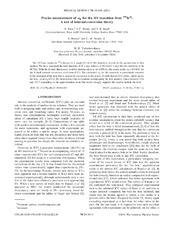| dc.creator | Nica, N. | |
| dc.creator | Hardy, John C. | |
| dc.creator | Iacob, VE | |
| dc.creator | Raman, S. | |
| dc.creator | Nestor, CW | |
| dc.creator | Trzhaskovskaya, MB. | |
| dc.date.accessioned | 2011-09-13T21:26:42Z | |
| dc.date.available | 2011-09-13T21:26:42Z | |
| dc.date.issued | 2004 | |
| dc.identifier.citation | N. Nica, John C. Hardy, VE Iacob, S. Raman, CW Nestor and MB Trzhaskovskaya. Phys.Rev.C 70 054305 2004. "Copyright (2004) by the American Physical Society." | en |
| dc.identifier.uri | http://dx.doi.org/10.1103/PhysRevC.70.054305 | |
| dc.identifier.uri | https://hdl.handle.net/1969.1/126974 | |
| dc.description | Journals published by the American Physical Society can be found at http://publish.aps.org/ | en |
| dc.description.abstract | The 10.5-day isomer in Ir-193 decays by a single 80.2-keV M4 transition directly to the ground state of that nucleus. We have measured the total intensity of K x rays relative to 80.2-keV gamma rays for this transition to be 98.7(6). With the K-shell fluorescent yield for iridium taken to be 0.958(4), this result yields alpha(K) = 103.0(8) for the K-shell internal conversion coefficient (ICC). The calculated alpha(K) for this transition is particularly sensitive to the treatment of the hole that is created by conversion in the atomic K shell. Recent ICC tables, which ignore the hole, yield alpha(K) = 92.0. We demonstrate that calculations incorporating the hole produce values between 99.6 and 103.3 depending on the approximation used. Our result strongly supports the need to include the hole. | en |
| dc.language.iso | en | |
| dc.publisher | American Physical Society | |
| dc.subject | MONTE-CARLO CALCULATIONS | en |
| dc.subject | EFFICIENCY CALIBRATION | en |
| dc.subject | HPGE DETECTOR | en |
| dc.subject | COEFFICIENTS | en |
| dc.subject | SHELL | en |
| dc.subject | Physics | en |
| dc.title | Precise measurement of alpha(K) for the M4 transition from Ir-193(m): A test of internal-conversion theory | en |
| dc.type | Article | en |
| local.department | Physics and Astronomy | en |


